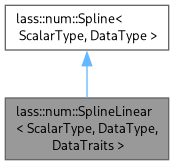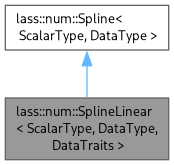connects the data nodes with linear segments. More...
#include <spline_linear.h>


Public Member Functions | |
| template<typename PairInputIterator> | |
| SplineLinear (PairInputIterator iFirst, PairInputIterator iLast) | |
| construct a spline from a range of control/data pairs. | |
| template<typename ScalarInputIterator, typename DataInputIterator> | |
| SplineLinear (ScalarInputIterator iFirstControl, ScalarInputIterator iLastControl, DataInputIterator iFirstData) | |
| construct a spline from seperate ranges. | |
| const TData | operator() (TScalar iX) const override |
| Get the linear interpolated data value that corresponds with constrol value iX. | |
| const TData | derivative (TScalar iX) const override |
| Get the first derivative of data value that corresponds with constrol value iX. | |
| const TData | integral (TScalar iA, TScalar iB) const override |
| Get the integrated data value between control points iA and iB. | |
| bool | isEmpty () const override |
| return true if the spline contains any nodes at all. | |
| const TControlRange | controlRange () const override |
| return the range of control values for which the spline can interpolate. | |
Detailed Description
class lass::num::SplineLinear< ScalarType, DataType, DataTraits >
connects the data nodes with linear segments.
Definition at line 67 of file spline_linear.h.
Constructor & Destructor Documentation
◆ SplineLinear() [1/2]
| lass::num::SplineLinear< S, D, T >::SplineLinear | ( | PairInputIterator | iFirst, |
| PairInputIterator | iLast ) |
construct a spline from a range of control/data pairs.
Each node consists of a control value and a data value. This contstructor accepts a single range [iFirst, iLast) of control/data pairs. The iterator type should have two fields first and second that contain respectively the control and data values. This is choosen so that a std::pair can be used as a representatin of the control/data pair.
- Precondition
- [iFirst, iLast) is a valid range.
PairInputIteratorhas a memberfirstcontaining the control valuePairInputIteratorhas a membersecondcontaining the data value
- complexity:
- O(D * log(N)) with
- D = a figure that indicates the complexity of operations on data values. Is most probably linear with the dimension of the data value
- N = number of nodes
Definition at line 86 of file spline_linear.inl.
◆ SplineLinear() [2/2]
| lass::num::SplineLinear< S, D, T >::SplineLinear | ( | ScalarInputIterator | iFirstControl, |
| ScalarInputIterator | iLastControl, | ||
| DataInputIterator | iFirstData ) |
construct a spline from seperate ranges.
Each node consists of a control value and a data value. This contstructor accepts seperate ranges for control and data values. The control values are given by the range [iFirstControl , iLastControl). Of the range of the data values, only the iterator iFirstData to the the first element is given.
- Precondition
- [iFirstControl, iLastControl) is a valid range.
- [iFirstData, iFirstData + (iLastControl - iFirstControl)) is a valid range.
- complexity:
- O(D * log(N)) with
- D = a figure that indicates the complexity of operations on data values. Is most probably linear with the dimension of the data value
- N = number of nodes
Definition at line 121 of file spline_linear.inl.
Member Function Documentation
◆ operator()()
|
overridevirtual |
Get the linear interpolated data value that corresponds with constrol value iX.
- Precondition
- this->isEmpty() == false
- complexity:
- O(D * log(N)) with
- D = a figure that indicates the complexity of operations on data values. Is most probably linear with the dimension of the data value
- N = number of nodes
Implements lass::num::Spline< ScalarType, DataType >.
Definition at line 149 of file spline_linear.inl.
References isEmpty().
◆ derivative()
|
overridevirtual |
Get the first derivative of data value that corresponds with constrol value iX.
As long as iX is exact on a node, it equals to lim_{dx->0} (*this(iX + dx) - *this(iX)) / dx. With linear splines, in theory the first derivative does not exist on the nodes. This function however will return the first derivative on the right of the node. *
- Precondition
- this->isEmpty() == false
- complexity:
- O(D * log(N)) with
- D = a figure that indicates the complexity of operations on data values. Is most probably linear with the dimension of the data value
- N = number of nodes
Implements lass::num::Spline< ScalarType, DataType >.
Definition at line 179 of file spline_linear.inl.
References isEmpty().
◆ integral()
|
overridevirtual |
Get the integrated data value between control points iA and iB.
- Precondition
- this->isEmpty() == false
- complexity:
- O(D * M * log(N)) with
- D = a figure that indicates the complexity of operations on data values. Is most probably linear with the dimension of the data value
- M = number of nodes between iA and iB.
- N = total number of nodes in spline
Implements lass::num::Spline< ScalarType, DataType >.
Definition at line 227 of file spline_linear.inl.
References isEmpty(), and lass::num::sqr().
◆ isEmpty()
|
overridevirtual |
return true if the spline contains any nodes at all.
- complexity:
- O(1)
Implements lass::num::Spline< ScalarType, DataType >.
Definition at line 283 of file spline_linear.inl.
Referenced by derivative(), integral(), and operator()().
◆ controlRange()
|
overridevirtual |
return the range of control values for which the spline can interpolate.
- complexity:
- O(1)
Implements lass::num::Spline< ScalarType, DataType >.
Definition at line 296 of file spline_linear.inl.
The documentation for this class was generated from the following files: